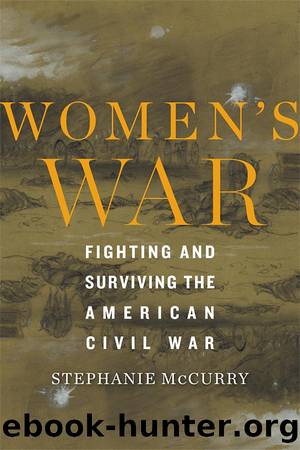Women's War - Fighting and Surviving the Civil War by Stephanie McCurry

Author:Stephanie McCurry [McCurry, Stephanie]
Language: eng
Format: epub
Tags: history, United States, Civil War Period (1850-1877), women, Social Science, Women's Studies
ISBN: 9780674987975
Google: WlWQDwAAQBAJ
Publisher: Harvard University Press
Published: 2019-11-15T00:17:08.572523+00:00
Confiscation was a real possibility in the political life of the nation in 1865 and 1866. Freed people looked to the federal government to distribute confiscated land as a return on loyalty and military service, and as a firm material foundation for their freedom. In Georgia, where General Sherman had issued his famous Special Field Order No. 15, they had a particularly strong case. âShermanâs Reserveâ was a thirty-mile-wide swath of land that ran south along the coast from Charleston to northern Florida. It had been seized from rebel owners by the US government and handed over to the control of the Freedmenâs Bureau for the settlement of freed people. At the end of the war, the bureau controlled more than 800,000 acres of land, half of it in South Carolina and Georgia. Other land remained subject to seizure for taxes or abandonment. Land tenure was extremely insecure.82 Unable to take the oath because of the terms of Johnsonâs amnesty, the Thomases, like the entire planter class, faced confiscation. Their situation was hardly the worst. Unlike fellow planters in more coastal parts of Georgia and South Carolina, they at least kept possession of their plantations. John Berkley Grimball and his wife, Meta Morris Grimball, were another couple who struggled to hold onto their property, much of it also inherited from her father. But their land fell within Shermanâs Reserve. The Grimballs had fled Edisto Island just ahead of the Union Army in December 1864, abandoning their plantations to the enslaved people who lived on them. It took until January 1866 to get them back. It was on Edisto, where his Grove and Pinebury plantations were located, that freedmen fought hardest for title to the land they had occupied and cultivated during the war.83
The defeat of the freed people in Shermanâs Reserve, by which the Grimballs regained possession of their plantations, came directly at the hands of Andrew Johnson. It was a dramatic turning point in Reconstruction. But the uncertainty surrounding land title dragged on into 1866, when Congress took up the debate.84 Gertrude Thomas was well aware of the sentiment in northern public opinion that confiscation was necessary to break the power of the old slaveholding class. âI donât care to learn anything of that economy or Christianity either which will confiscate any more of my property,â she fretted in October 1866. âTimes are gloomy and threatening,â and there could be no doubt about the âplans radicals propose.â85
Andrew Johnson, in a significant turn, emerged as the unlikely savior of the southern planter class. âThe rebels have again their heads up like kissing mares,â Francis Lieber wrote with disgust. âJohnson has revived them.â Johnsonâs liberal use of the pardon power was crucial, as was his directive to restore land to all pardoned owners. About fifteen thousand people applied for presidential pardons, most because of the value of their property, and about seven thousand were granted.86 At some point in those volatile postwar years, Jefferson Thomas also received one. It is not
Download
This site does not store any files on its server. We only index and link to content provided by other sites. Please contact the content providers to delete copyright contents if any and email us, we'll remove relevant links or contents immediately.
| Africa | Americas |
| Arctic & Antarctica | Asia |
| Australia & Oceania | Europe |
| Middle East | Russia |
| United States | World |
| Ancient Civilizations | Military |
| Historical Study & Educational Resources |
Machine Learning at Scale with H2O by Gregory Keys | David Whiting(4195)
Never by Ken Follett(3799)
Fairy Tale by Stephen King(3223)
The Man Who Died Twice by Richard Osman(2998)
Oathbringer (The Stormlight Archive, Book 3) by Brandon Sanderson(2902)
Will by Will Smith(2795)
Rationality by Steven Pinker(2291)
The Dark Hours by Michael Connelly(2246)
Can't Hurt Me: Master Your Mind and Defy the Odds - Clean Edition by David Goggins(2230)
Friends, Lovers, and the Big Terrible Thing by Matthew Perry(2126)
The Dawn of Everything: A New History of Humanity by David Graeber & David Wengrow(2123)
Principles for Dealing With the Changing World Order: Why Nations Succeed and Fail by Ray Dalio(1974)
HBR's 10 Must Reads 2022 by Harvard Business Review(1779)
A Short History of War by Jeremy Black(1764)
Go Tell the Bees That I Am Gone by Diana Gabaldon(1689)
515945210 by Unknown(1602)
A Game of Thrones (The Illustrated Edition) by George R. R. Martin(1594)
Kingdom of Ash by Maas Sarah J(1529)
443319537 by Unknown(1472)
